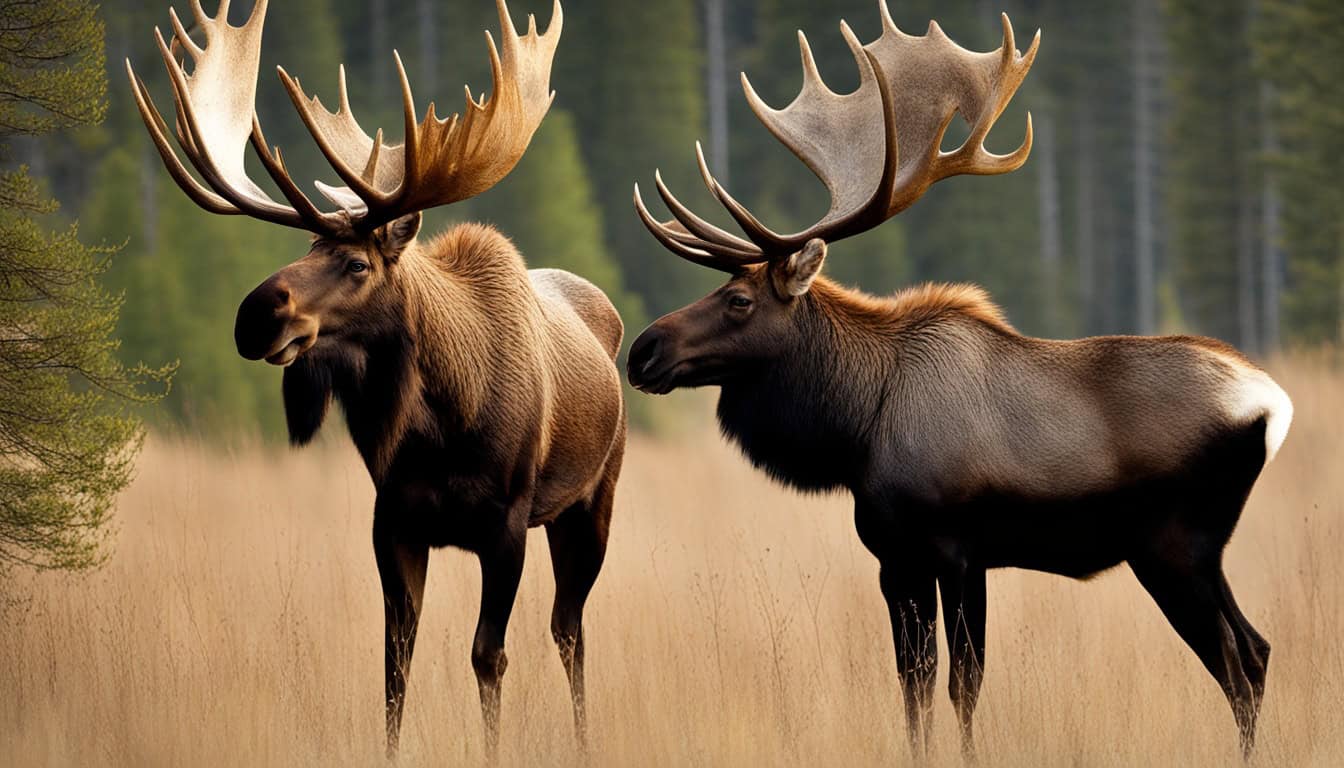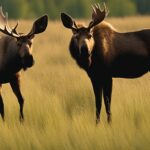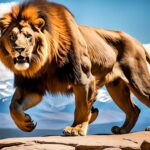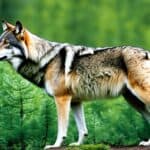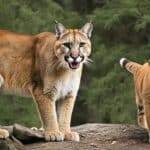Ever been curious about telling moose and elk apart in the wild? Knowing this is key for both hunters and nature lovers. It helps us protect the environment and follow the rules.
Differentiating a moose from an elk is intriguing. Moose are larger with darker fur and antlers that stick out. Elks, though, have a thin, pointed nose, unlike the round nose of a moose.
Learning these key traits is important for safe wildlife watching. This is especially true in places like Colorado. There, moose and elk have made a strong comeback since the early ’90s.
Introduction to Moose and Elk
Learning about the moose vs elk characteristics can be very interesting. These big animals are part of the deer family. But, they show different features. For example, both lose their antlers every year. People hunt them for food. But, they are quite different when you look closely.
Moose are usually bigger than elk. Moose like to be alone, but elk enjoy being with others. Their color is another difference. Moose have a dark shade while elk are lighter. This makes them easy to tell apart.
Moose and elk also act differently. Moose are often alone and explore the wild solo. Elk, however, live in groups. This makes their behavior another way to tell them apart. Watching how they move and where they live can help you understand them better.
By looking at both how they look and how they act, we can see the clear differences. These clues help us know the moose and elk comparison. It makes it easier to see what makes each species special.
Habitat Differences Between Moose and Elk
It’s important to know where moose and elk live to see the differences between them. Their habitats are partly the reason we can tell these impressive animals apart.
Moose Habitats
Moose live in the colder parts of the northern US and Canada. They like places with lots of water, like lakes and rivers, and areas with a lot of wetlands. These spots are good for finding the plants they eat. In winter, moose often stay in coniferous forests and other places with thick growth for warmth and safety from predators.
Elk Habitats
Elk can live in many different places, including forests, meadows, and mountains. They don’t need as much water as moose do. Elk usually like the areas at the edge of forests and open plains. They choose places that have both trees and open areas for food and cover. Elk might move up to higher places to stay cool in summer and then head down to warmer, sheltered spots in winter.
| Feature | Moose Habitats | Elk Habitats |
|---|---|---|
| Climate | Colder, Northern Regions | Varied, Including Mountains and Plains |
| Main Vegetation | Aquatic Plants | Grasses and Perennial Plants |
| Preferred Areas | Wetlands and Dense Forests | Forest Edges and Open Plains |
Physical Size Comparison
Moose and elk have clear differences in size. Moose are much bigger than elk. This makes it easier to tell them apart.
Shoulder Height
Moose and elk are visibly different in shoulder height. A moose usually stands between 6 to 7 feet at the shoulder. In comparison, an elk’s shoulder height is about 4 to 5 feet. Understanding this helps when looking at them in the wild.
Weight Differences
The weight difference between a moose and elk is striking. Moose bulls can tip the scales at over 1,000 pounds. In contrast, elk typically weigh around 600 pounds. Knowing this can help you spot them while exploring nature.
Coat Color and Pattern
Understanding the moose coat color and pattern next to the elk coat color and pattern helps tell them apart. This difference is key in making sure you know which animal is which from far away. It’s all about being able to spot the details.
Moose Coat Characteristics
The main color of a moose’s coat is a deep chocolate brown. There are no light spots, even on the rump. This dark, solid color is a key feature of a moose’s look, making them very noticeable in the wild.
Elk Coat Characteristics
On the other hand, the elk’s coat color and pattern is a lighter brown, with a darker neck. What really stands out is the light spot on the elk’s rump. This clear contrast helps you tell elks and moose apart. It also shows off the beauty of both animals in a special way.
Antler Structure
The shape of antlers helps tell moose and elk apart. This is especially useful during hunting. Moose antlers are broad and flat while elk antlers point backward.
Moose Antlers
Moose antlers look like wide paddles with lots of points. They grow out from the moose’s head. This makes them very wide and impressive. The paddle look is a clear sign they belong to a moose, not an elk.
Elk Antlers
Elk antlers are mainly known for their backward-growing shape. They include a main beam and points, looking like a tree branch. The backwards arch makes them very different from moose antlers.
| Feature | Moose Antlers Description | Elk Antlers Identification |
|---|---|---|
| Shape | Broad and flat, paddle-like | Main beam extending backward with distinct points |
| Growth Direction | Outward from the head | Backward from the head |
| Visual Impact | Wide span | Tree-branch appearance |
Facial Features: Moose vs Elk
When looking at moose and elk up close, you’ll notice their faces differ a lot. Their nose shapes are especially different. This is a key thing to notice.

Moose Nose Shape
Moose have a long, rounded nose. It stands out in the deer family because of its broad and round look. This big, round nose is their most telling feature.
Elk Nose Shape
Elk, on the other hand, have noses that are narrow and pointed. Their noses are more pointy and sharp than a moose’s. This, along with their other facial features, helps spot elk apart from moose.
| Feature | Moose | Elk |
|---|---|---|
| Nose Shape | Long, Rounded | Narrow, Pointed |
Unique Features of Moose
It’s important to know what makes a moose stand out. The big flap under a moose’s throat is called a dewlap. It hangs down like a bell.
Dewlap/Bell
Moose have a special flap of skin under their chin that elk do not. We call it a dewlap or bell. It looks different in each moose but helps us tell them apart from elk easily.
Other Distinguishing Characteristics
Moose have unique physical features like a heavier body and big, round hooves. They are big animals. Their round hooves make different tracks than elk, like big, wide prints instead of small, sharp ones.
| Characteristic | Moose | Elk |
|---|---|---|
| Dewlap/Bell | Present | Absent |
| Hoof Shape | Rounded | Tooth-shaped |
| Build | Heavier and robust | Lean and agile |
Behavioral Differences
Spotting the difference between a moose and an elk is easy when you look at how they behave. Their social habits and the way they move around can tell us a lot. These signs help us understand both their world and ours better.
Social Behavior
Moose tend to be on their own, away from others. You often see a single moose wandering by itself. This is key to remember when trying to identify them.
Elk, on the other hand, prefer to stick together. They form large groups, especially where they find plenty of food. Living in herds offers elk safety and a sense of community.
Mobility and Agility
Elk are quick and agile. They can swiftly move through forests, mountains, and meadows. This helps them keep safe from danger and travel long distances.
While moose can also get around their habitat, they’re not as fast as elk. Their larger size means they move more slowly and with care. Moose prefer a steady pace over the quick jumps of elk.
| Behavioral Aspect | Moose | Elk |
|---|---|---|
| Social Behavior | Mostly solitary | Gregarious, often in herds |
| Mobility and Agility | Slower, deliberate movements | Highly agile and swift |
How can you tell the difference between a moose and an elk?
To tell moose and elk apart, look at their size and features. Moose are bigger than elk, reaching up to 7 feet at the shoulder. They can weigh over 1,000 pounds. In comparison, elk are about 4 to 5 feet at the shoulder and weigh around 600 pounds.
Check their coats too. Moose are dark brown without any pale areas on their rump. Elk are lighter, with a light patch on their rump. This makes elk easier to see from far away. Antlers can also help you figure it out. Moose have broad, flat antlers that look like paddles. Elk antlers are pointed and form a “V” shape.
Next, look at their faces. Moose have rounded noses, while elk have sharp, pointed noses. Moose also have a bell or dewlap, and their hooves are large and round. Moose prefer to be alone, while elk live in herds. Elk are also quicker and more agile.
Using these clues—like size, color, antlers, noses, and behaviors—you can confidently spot the difference. These methods are key for anyone interested in wildlife, from hunters to nature lovers.
FAQ
How can you tell the difference between a moose and an elk?
Moose and elk differ in size, color, and antlers. Moose are bigger and have dark coats. They also have flat, wide antlers and a rounded nose. Elk, on the other hand, are not as big. They have light coats, antlers that point backwards, and a narrow, pointed nose.
What are the distinguishing features of moose and elk?
Size, coat color, and antler shape set moose and elk apart. Moose have a broad antlers, a dark brown coat, and a round nose. Elk, meanwhile, are smaller with light coats and antlers that extend backwards. They have a pointed nose too. These unique features make them easier to tell apart.
What are the habitat differences between moose and elk?
Moose prefer cold areas with a lot of water and plants. They live in the northern U.S. mostly. Elk, though, live in more varied places. They are found in mountains, forests, and wide open areas. This makes their home range much larger than that of moose.
How do the sizes of moose and elk compare?
Moose are the biggest, reaching 6 to 7 feet at the shoulder and over 1,000 pounds. Elk, in comparison, are smaller. They stand about 4 to 5 feet at the shoulder and weigh around 600 pounds.
How can you identify a moose or an elk by their coat color?
Moose coats are a dark, solid brown with no light spots on the rump. Elk have a lighter brown coat with a dark neck. This difference is helpful, especially when they are far away.
What are the differences in antler structures between moose and elk?
Antlers are another way to tell them apart. Moose antlers are wide and flat, like paddles, with points. Elk antlers extend backward and have a large beam with points. This helps a lot during hunting season when accurate identification is needed.
How do the facial features of moose and elk differ?
Moose and elk have different noses. A moose has a long, round nose not like the elk’s narrow, pointed one. This difference is great for up-close or detailed observations.
What unique features help in identifying a moose?
Moose have a bell or dewlap under their jaw, which elk don’t have. They are also built larger and their hooves are round. Elk’s tracks look more like a tooth shape.
How do the social behaviors of moose and elk differ?
Elk are often found in groups, but moose are usually alone. This means seeing them in either a group or on their own can help identify them.
How can mobility and agility help differentiate between moose and elk?
Elk move nimbly, showing off their agility, while moose are slower because of their size. Observing how they move can aid in telling them apart.

